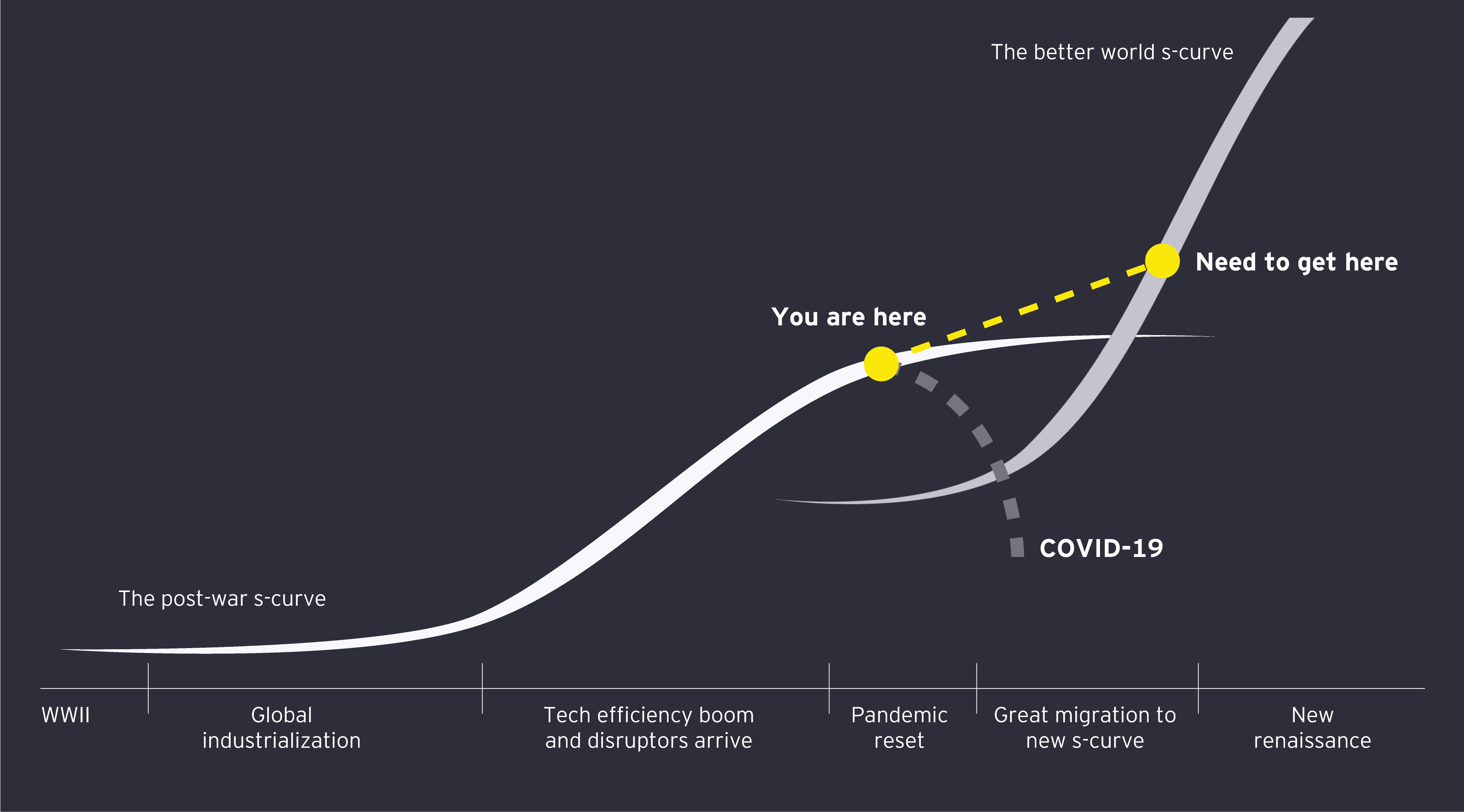Companies that use data to gain a deep understanding of their customers and provide unique experiences will exponentially accelerate along the next S-curve of growth.
A future-back approach sets the strategy for innovating at scale
Innovating at scale along this new growth trajectory requires companies to take a future-back approach to strategic planning, as exponential value creators have done in previous times of crisis and change. Leaders of these companies look into the distant future and consider whether their business will be as relevant then as it is now. They then use their purpose to explore their opportunities and their vision to work future-back scenarios that make sure they are following a path where the priorities and actions of today are positioning them on a relevant and exponential trajectory for 15 or 20 years down the road.
With future scenarios as a starting point, companies can then create a multi-horizon strategic map that charts a course from the future back to today. The latest EY Megatrends report is a think-tank research report on global futures and highlights five steps for developing a future-back strategy using megatrends as a foundation. The concept of future-back planning results in an ability to break free from past assumptions, explore megatrends that will change the world and identify weak signals beginning to reveal the future. From there, organizations can use that understanding, today, to develop a better strategic investment and transformation plans.
Future-back planning provides an opportunity to break free from past assumptions, explore megatrends that will change the world and identify weak signals beginning to reveal the future. Organizations can use that understanding, today, to develop a better strategic investment and transformation plans.
Data will be the differentiator between products and unique experiences
Technologically, companies looking to make the leap from middle of the pack to exponential value creators, will need to more effectively harness the reams of data they are already collecting and generate vast amounts beyond what we collect today.
In the 2020 EY Tech Horizon survey, 83% of digital transformation leaders understood the value their companies could gain from leveraging data and analytics insights to speed innovation. Even 70% of digital transformation laggards see the same value.
Understanding the value data can bring
83%of digital transformation leaders use data to help them innovate faster.
The 2022 Tech Horizon survey uncovered new insights into technology transformation and investment strategies.
To be successful, organizational leaders need to see data as an asset worth investing in. Further, companies will want to act on the following three innovation imperatives, as outlined in How data can help you innovate when change is constant:
- Assemble the right teams that have experience across strategic change, design thinking, data science and industry knowledge. They’ll be able to ask the right questions to get the right results.
- Develop a human-centered innovation business model, operating model, and culture that embraces and drives change. Using data to augment the capabilities and experiences for people in innovative new ways is the key to realized value.
- Deliver insights and results fast and have a clear plan for industrialization. Analytics sprints can help teams iterate through business questions, starting simply and becoming increasingly complex to support new innovations that can be embedded at scale.
Of course, any actions companies take to strengthen their data and analytics, and artificial intelligence capabilities will need to tie back to the future-back strategy the company has set.
Customer expectations propel operational value chains into an autonomous era
Operationally, value chains will need to evolve to keep pace with making innovations tangible and real in terms of products and services for customers. For years, companies have relied predominantly on efficient, just-in-time supply chains that mass produce products to ship in bulk to customers. In delivering hyper-personalized experiences, companies will need to move toward flexible, resilient supply networks that are highly responsive to local needs, and flexible enough to reconfigure and deliver new products and services quickly.
In a networked era, supply chains will be data-driven and allow for end-to-end visibility, hyper personalization and real-time communication. This will allow companies to manufacture uniquely designed, bespoke products at scale. Emerging technologies also will play a critical role in disruptive innovation by helping companies to make real-time decisions and integrate data to source, make, sell and deliver their products.
In an autonomous era, companies will produce products at or nearer to the source of consumption. In this new autonomous reality, items would be available to customers on-demand and in real-time by accessing the flow of intellectual property and production when needed and producing products in seconds.
If the goal is to deliver hyper-personalized experiences, companies will need to move toward resilient supply networks that are highly responsive to local needs, and flexible enough to reconfigure and deliver new products and services quickly.
Along the new S-curve, the beyond is closer than we think
Along the new S-curve of growth, innovating at scale will require companies to place humans at the center of their customer journey, develop a future-back strategy, harness their customer data to deliver unique experiences and turn their supply chains into networked then autonomous supply networks. By understanding individual customer needs and delivering at scale in real time, companies can find themselves leading the next generation of post-pandemic disruptors into a beyond that is closer than we think.
Summary
A new S-curve of growth is on the way and innovative companies are already leaving behind the traditional drivers of scope, scale and efficiency. Innovating at scale along this new growth trajectory requires companies to take a future-back approach to strategic planning, to see data as an asset worth investing in, and to move toward resilient supply networks that are data driven and enable hyper personalization.

